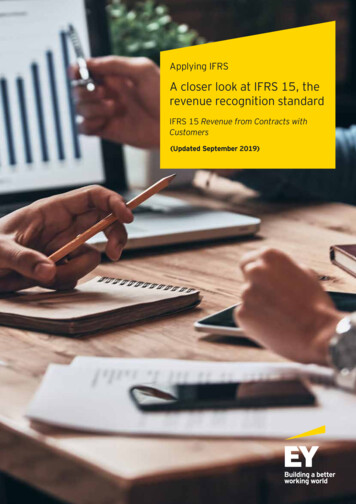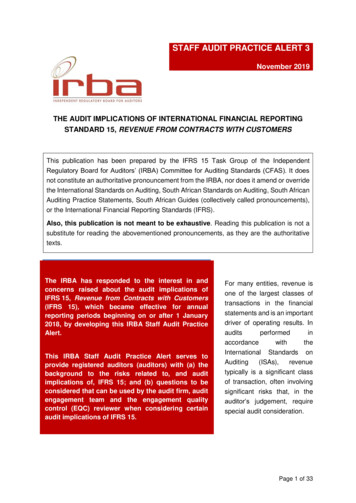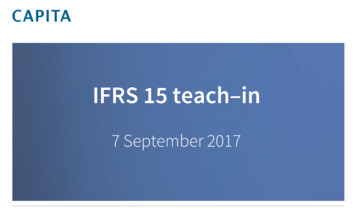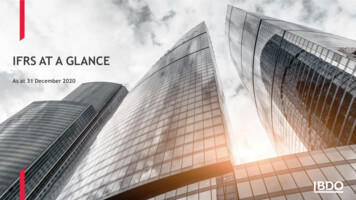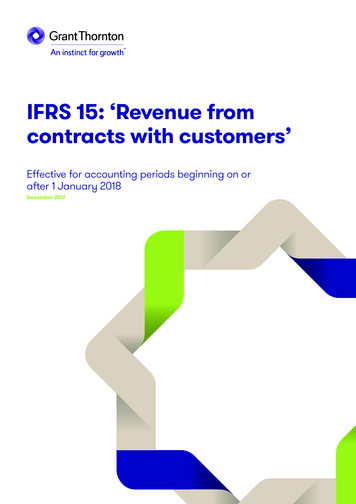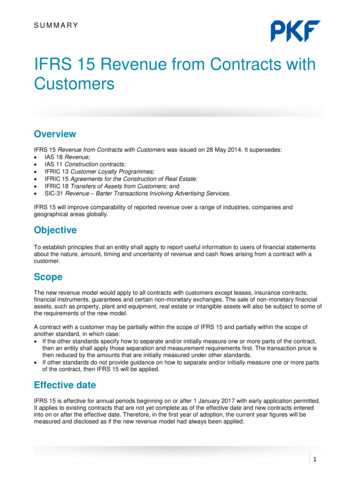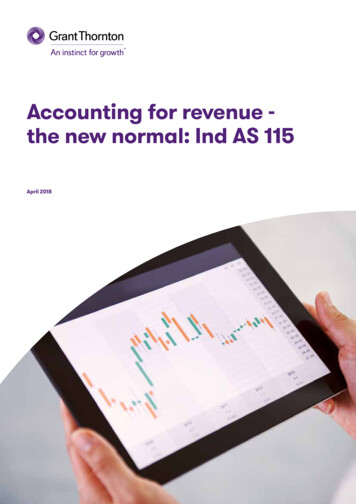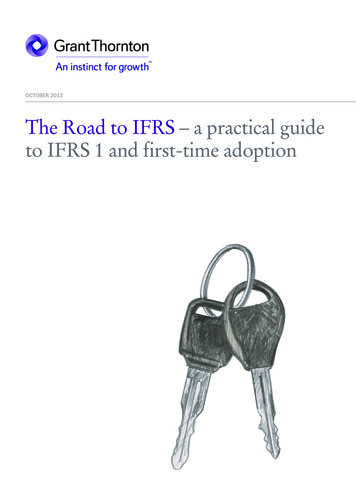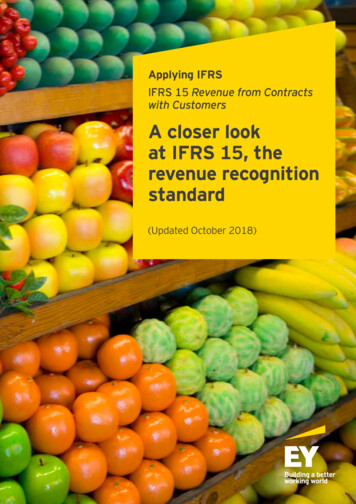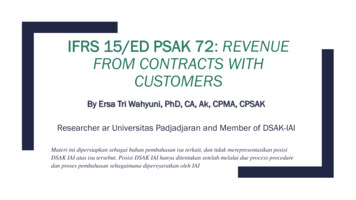
Transcription
IFRS 15/ED PSAK 72: REVENUEFROM CONTRACTS WITHCUSTOMERSBy Ersa Tri Wahyuni, PhD, CA, Ak, CPMA, CPSAKResearcher ar Universitas Padjadjaran and Member of DSAK-IAIMateri ini dipersiapkan sebagai bahan pembahasan isu terkait, dan tidak merepresentasikan posisiDSAK IAI atas isu tersebut. Posisi DSAK IAI hanya ditentukan setelah melalui due process proceduredan proses pembahasan sebagaimana dipersyaratkan oleh IAI
Perjalanan IFRS 15Joint IASB/FASB TRGDiscussionsampai Nov 2015IFRS 15 terbitMei2014FASB melanjutkan TRGDiscussion (US-only)Clarifications to IFRS15April 20161 Januari 2016Penerbitan IFRS 16LeasesED PSAK 72 mengadopsiIFRS 15 setelahamandemen dan tdkmengakomodir IFRS 16Transisi modified retrospective(tidak1adapenyajian kembali)Januari20181 Januari 2017Transisi fullretrospectiveTanggal efektif ED PSAK 72,(1 tahun komparatif)1 Januari 20192
PSAK & ISAK TerdampakPSAKa.PSAK 34: Kontrak Konstruksi (IAS 11 Construction Contracts);b.PSAK 23: Pendapatan (IAS 18 Revenue);ISAKa.ISAK 10: Program Loyalitas Pelanggan (IFRIC 13 Customers LoyaltyProgrammes);b.ISAK 21: Perjanjian Konstruksi Real Estat (IFRIC 15 Agreements forthe Construction of Real Estate);Dicabutdengan EDPSAK 72c.ISAK 27: Pengalihan Aset Dari Pelanggan (IFRIC 18 Transfers ofAssets from Customers); danPSAK 44: Akuntansi Aktivitas Pengembangan Real EstatPPSAK 7: Pencabutan PSAK 44:Akuntansi AktivitasPengembangan Real Estat akanberlaku efektif sejak entitasmenerapkan IFRS 15 pertamakali3
Ruang LingkupED PSAK 72 diterapkan untuk seluruh kontrak pelanggan, kecuali:12 kontrak dalam ruang lingkup sewa (PSAK 30); kontrak asuransi (PSAK 62);3 instrumen keuangan dan hak atau kewajiban kontraktual lainPSAK 71; PSAK 65; PSAK 66; PSAK 15; PSAK 4)(ED4 pertukaran nonmoneter antara entitas dalam lini bisnis yang samauntuk memfasilitasi penjualan pelanggan atau pelanggan potensial.4
Introduction to IFRS 15: Revenue fromContracts with Customers5STEPS TO RECOGNISEREVENUEIdentify thecontract(s)with thecustomerIdentify theperformanceobligation inthe contractDetermine thetransactionpriceAllocate thetransactionRecogniserevenue when(or as) theentity satisfiesa performanceobligation5
Introduction to IFRS 15: Revenue fromContracts with CustomersIFRS 15: Removes inconsistencies and weaknesses in previous revenuerequirements; IFRS 15 addresses those deficiencies by specifying a comprehensive androbust framework for the recognition, measurement and disclosure ofrevenue; Improves comparability of revenue recognition practices across entities,industries, jurisdictions and capital markets; Reduces the need for interpretive guidance to be developed on a caseby-case basis to address emerging revenue recognition issues; and Provides more useful information through improved disclosurerequirements.6
Introduction to IFRS 15: Revenue fromContracts with CustomersBEFORE IFRS 15W A S I S S U E D:IFRS15Effective on or after 1 Jan2017INCONSISTENCIES ANDWEAKNESSES in revenuestandardContracts with customer thatare economically similar willbe accounted for on aCONSISTENT BASISresult&Companies accounting forSIMILAR transactionDIFFERENTLYResult in CHANGES in theaccounting for certainrevenue transaction for somecompanies.7
Timeline IFRS 15Joint IASB/FASB TRG DiscussionUntil Nov 2015IFRS 15 issuedMay 2014ED PSAK 72 adopt IFRS 15 afteramendment (not accommodateIFRS 16)FASB continuing TRG Discussion (USonly)Clarifications to IFRS 15April 20161 January 2016Penerbitan IFRS 16 LeasesTransition modified retrospective(no restatement)1 January 20181 January 2017Transisi full retrospective(1 year comparative)Effective dateED PSAK 72, 1 January 20198
5 Steps Model – Revenue Recognition9
1. Identifying Contracts with Customers (Paragraf 09)Written Oralthe parties to the contract have approved the contract (in writing, orally or in accordance with other customarybusiness practices) and are committed to perform their respective obligations;the entity can identify each party’s rights regarding the goods or services to be transferred;the entity can identify the payment terms for the goods or services to be transferred;the contract has commercial substance ((ie the risk, timing or amount of the entity’s future cash flows is expected tochange as a result of the contract); andit is probable that the entity will collect the consideration to which it will be entitled in exchange for the goods orservices that will be transferred to the customer.10
When a contract with a customer does not meet the criteria in paragraph 9 and an entityreceives consideration from the customer, the entity shall recognise the consideration receivedas revenue only when either of the following events has occurred: the entity has no remainingobligations to transfer goods orservices to the customer and all, orsubstantially all, of theconsideration promised by thecustomer has been received by theentity and is non-refundable; orOR the contract has been terminated and theconsideration received from the customeris non-refundable.11
Combination of ContractsAn entity shall combine two or more contracts entered into at or near the same time with thesame customer (or related parties of the customer) and account for the contracts as a singlecontract if one or more of the following criteria are met:– the contracts are negotiated as a package with a single commercial objective;– the amount of consideration to be paid in one contract depends on the price orperformance of the other contract; or– the goods or services promised in the contracts (or some goods or servicespromised in each of the contracts) are a single performance obligation inaccordance with paragraphs 22–30.12
Contract ModificationsAn entity shall account for a contract modification as a separate contract if bothof the following conditions are present: the scope of the contract increases because of the addition of promised goods or servicesthat are distinct (in accordance with paragraphs 26–30); and the price of the contract increases by an amount of consideration that reflects the entity’s stand-aloneselling prices of the additional promised goods or services and any appropriate adjustments to thatprice to reflect the circumstances of the particular contract.13
2. Identifying performance obligations(Paragraph 22)At contract inception, an entity shall assess the goods or services promised in a contract with acustomer and shall identify as a performance obligation each promise to transfer to the customereither: a good or service (or a bundle of goods or services) that is distinct; or a series of distinct goods or services that are substantially the same and that have the samepattern of transfer to the customer (see paragraph 23).14
A Good or Service is DiscinctA good or service that is promised to a customer is distinct if both of the followingcriteria are met: the customer can benefit from the good or service either on its own or together withother resources that are readily available to the customer (ie the good or service iscapable of being distinct); and the entity’s promise to transfer the good or service to the customer is separatelyidentifiable from other promises in the contract (ie the promise to transfer the goodor service is distinct within the context of the contract).15
3. Determining Transaction Price (paragraph 48)The nature, timing and amount of consideration promised by a customer affect the estimateof the transaction price. When determining the transaction price, an entity shall consider theeffects of all of the following: variable consideration (see paragraphs 50–55 and 59); constraining estimates of variable consideration (see paragraphs 56–58); the existence of a significant financing component in the contract (see paragraphs 60–65); non-cash consideration (see paragraphs 66–69); and consideration payable to a customer (see paragraphs 70–72).16
4. Allocating The Transaction Price To PerformanceObligations (Paragraph 74) an entity shall allocate the transaction price to each performance obligationidentified in the contract on a relative stand-alone selling price basis If a stand-alone selling price is not directly observable, an entity shallestimate the stand-alone selling price at an amount that would result in theallocation of the transaction price meeting the allocation objective inparagraph 73. Discount (Paragraf 82) and variable consideration (Pargaraf 85) is allocatedentirely to each performance obligations if meet the criteria.17
5. Entity Shall Recognise Revenue When (Or As) The Entity Satisfies APerformance Obligation (Paragraph 31)An entity shall recognise revenue when (or as) the entity satisfies a performance obligation bytransferring a promised good or service (ie an asset) to a customer. An asset is transferredwhen (or as) the customer obtains control of that asset.Performance obligations satisfied at a pointin timePerformance obligations satisfied over timeIf a performance obligation is not satisfied over timean entitysatisfies the performance obligation at a point in time. Todetermine the point in time at which a customer obtainscontrol of a promised asset and the entity satisfies aperformance obligation, the entity shall consider therequirements for control in paragraphs 31–3418
Criteria Performance Obligations Satisfied Over Time the customer simultaneously receives and consumes the benefitsprovided by the entity’s performance as the entity performs (seeparagraphs B3–B4); the entity’s performance creates or enhances an asset (forexample, work in progress) that the customer controls as theasset is created or enhanced (see paragraph B5); or the entity’s performance does not create an asset with analternative use to the entity (see paragraph 36) and the entity hasan enforceable right to payment for performance completed todate (see paragraph 37).19
Performance Obligations Satisfied At A Point In Time If a performance obligation is not satisfied over time in accordance with paragraphs 35–37,an entity satisfies the performance obligation at a point in time. To determine the point intime at which a customer obtains control of a promised asset and the entity satisfies aperformance obligation, the entity shall consider the requirements for control in paragraphs31–34. an entity shall consider indicators of the transfer of control, which include, but are not limitedto, the following:–The entity has a present right to payment for the asset–The customer has legal title to the asset–The entity has transferred physical possession of the asset–The customer has the significant risks and rewards of ownership of the asset–The customer has accepted the asset20
Presentation and Disclosurean entity shall present the contract in the statement of financial position as a contract asset or acontract liability, depending on the relationship between the entity’s performance and thecustomer’s payment. An entity shall present any unconditional rights to consideration separatelyas a receivable.an entity shall disclose qualitative and quantitative information about all of the following: its contracts with customers (see paragraphs 113–122); the significant judgements, and changes in the judgements, made in applying this Standardto those contracts (see paragraphs 123–126); and any assets recognised from the costs to obtain or fulfil a contract with a customer inaccordance with paragraph 91 or 95 (see paragraphs 127–128).21
Implementation Guidance (Appendix B) This appendix is an integral part of the EDPSAK 72. This application guidance is organised intothe following categories:– performance obligations satisfied overtime;– methods for measuring progresstowards complete satisfaction of aperformance obligation;– sale with a right of return;– warranties;– principal versus agent considerations;– customer options for additional goodsor services;– customers’ unexercised rights;– non-refundable upfront fees (and somerelated costs);– licensing;– repurchase agreements;– consignment arrangements;– bill-and-hold arrangements;– customer acceptance; and– disclosure of disaggregated revenue22
THE IMPACT OF IFRS 15ON INDUSTRIES23
CONSTRUCTIONIs revenue accounted over time or at a point in time? IFRS 15 requiring careful assessment to determine if revenue and profit canbe recognized progressively over time. If the contract arrangements do not permit revenue to be recognisedprogressively, then revenue is recognised at a specific point in time ontransfer of control, which for a construction contract will likely to be closed tocompletionHow should a contractor measure contract progress? Stage of completion which could be measured by several methods: contractcost incurred to date as a percentage of total forecast cost, surveys of workperformed, physical completion24
MININGIn particular, mining companies need to consider: Whether the new control model will change the timing of revenue recognition Whether freight revenue will need to be accounted for separately if control ofgoods passes before final delivery The impact of the new guidance where pricing mechanism include variableconsideration The extent to which arrangements with collaborators or partners, which mightinclude royalty funding arrangements, fall within the scope of new standard Whether revenue must be adjusted for the effect of the time value of money The appropriate accounting for exchanges of inventory25
REAL ESTATEIn particular, real estate companies need to consider: Whether revenue should be recognized over time or at point in a time The extent to which distinct goods or services are supplied, which should beaccounted for separately Whether particular cost relating to obtaining a contract must be capitalized Whether revenue must be adjusted for the effect of the time value of money How to account for contract modification The impact of the new guidance where pricing mechanism include variableamount26
Challenges for Construction Industrya point in time VS Over Time The amount of revenue recognised is the amount allocated to the satisfied performanceobligation. A performance obligation may be satisfied at a point in time (typically for promises totransfer goods to a customer) or over time (typically for promises to transfer services toa customer). recognises revenue over time, if one of the following criteria is met:– the customer simultaneously receives and consumes the benefits provided bythe entity’s performance as the entity performs (see paragraphs B3–B4);– the entity’s performance creates or enhances an asset (for example, work inprogress) that the customer controls as the asset is created or enhanced (seeparagraph B5); or– the entity’s performance does not create an asset with an alternative use tothe entity (see paragraph 36) and the entity has an enforceable right topayment for performance completed to date (see paragraph 37).27
Construction Industry in Indonesia Number of real estate listed companies : 49 Total market capitalization: 5.79% from total or IDR 329.11 trillion Total real estate listed companies uses PSAK 44 : 47 companies It can be challenging for Indonesian real estate companies becausecurrent accounting standard (PSAK 44) is rule based standard andallowed “over time” recognition Real Estate companies needs to evaluate the impact of IFRS 15 totheir revenue recognition DSAK-IAI is working with the industry association by conductingmeetings with them28
BANKING AND SECURITIESMost significant changes:- When should variable or uncertain revenues be recognized- Which cost should be capitalized- How should an entity identify and allocate revenue to different goods andservices- When should upront fees be recognised- How should credit card loyalty schemes recognisedThe wider implication of IFRS 15 might include: Changes to the profile of tax cash payments Availability of profits for distribution For compensation and bonus plans, impact on the timing of targets beingachieved and the likelihood of targets being met29
TRAVEL, HOSPITALITY, AND LEISUREIn particular, travel, hospitality, and leisure companies will need to consider: When upront fees should be recognized as revenue The accounting for breakage The types of license that are sold and whether the accounting treatement willneed to change The impact of the new guidance where pricing mechanism include variableamount The extent to which distinct goods or services are supplied, which should beaccounted for separately30
HEALTHCARE PROVIDERIn particular, healthcare providers will need to consider: The impact of new guidance where pricing mechanism include variableamounts Whether payment for goods and services is considered collectable (receipt isprobable) The extent to which distinct goods or services are supplied, which should beaccounted for separately Whether particular costs relating to obtaining a contract must be capitalized31
TECHNOLOGYIn particular, technology company will need to consider: The extent to which distinct goods or services are supplied, which should beaccounted for separately Whether revenue should be recognized over time or at a point in time The types of license that are sold and whether the accounting treatment willneed to change The impact of guidance where pricing mechanism include variable amount How to account for contract modification32
TECHNOLOGYIn particular, telecommunication companies will need to consider: Whether they are able to apply the portofolio approach to groups of contracts The impact of the new guidance on allocating revenue to all goods andservices in a contract How to account for contract modification Whether particular costs relating to obtaining a contract must be capitalized Whether revenue must be adjusted for the effect of the time value of money33
AUTOMOTIVEIn particular, automotive company will need to consider: Whether revenue should be recognized over time or at a point in time The impact of the new guidance where pricing mechanism include variableamounts Types of warranty coverage offered to customers The extent to which distinct goods or services are supplied, which should beaccounted for separately Whether certain offers of vehicles fall within the scope of the new standard34
REFERENCE: IFRS INDUSTRY INSIGHT ON THE IMPACT OF IFRS 15: rs-insights-revenue IFRS 15 – IMPACT OF APPLICATION (AUGUST 2015) : www.frc.govmu.org IFRS 15 – the new revenue recognition standard, impact on mining – EY:www.ey.com Impact on the construction industry of the new revenue – KPMG:https://home.kpmg.com35
THANK YOUERSAWAHYUNI@GMAIL.COMTwitter : @ersatriwahyuniBlog: etw-accountant.com36
IFRS 15/ED PSAK 72: REVENUE FROM CONTRACTS WITH CUSTOMERS By Ersa Tri Wahyuni, PhD, CA, Ak, CPMA, CPSAK Researcher ar Universitas Padjadjaran and Member of DSAK-IAI Materi ini dipersiapkan sebagai bahan pembahasan isu terkait, dan tidak merepresentasikan posisi DSAK
